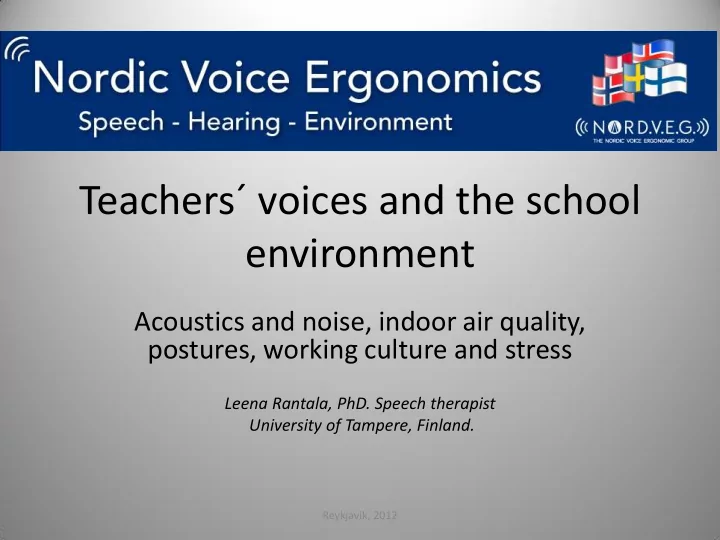

Teachers´ voices and the school environment Acoustics and noise, indoor air quality, postures, working culture and stress Leena Rantala, PhD. Speech therapist University of Tampere, Finland. Reykjavik, 2012
The risks for voice disorders are partly (65 %) related to the work environment Symptoms of environmental origin: voice gets strained or tires (Simberg et al. -09, -12) Reykjavik, 2012
Voice symptoms in teachers Angelillo et al. -09 Reykjavik, 2012
Study: connections between voice ergonomic risk factors and voice Voice ergonomic assessment Acoustics and noise, indoor air quality, postures, working culture and stress Voice symptoms and voice production Respiratory tract diseases Reykjavik, 2012
Acoustics and noise • Effects of poor acoustics – Noise is continuous • Increases psychological stress • Decrease concentration – Transmission of speech is poor • Decrease concentration > Increases psychological stress – Impairs reading comprehension and long-term memory • Background noise – Loud in schools and nursery schools – raises voice loudness (Lombard effect) Reykjavik, 2012
Study: in poor acoustics and noise • More voice symptoms • Activity and background noise – Voice quality more strained before a working day but changes less during work • Background noise – Louder voice (sound pressure level) before and after a working day), but changes less – Lower voice pitch in males (before and after) Reykjavik, 2012
Indoor air quality • Poor in many European school – Ventilation does not work – Mold 14 – 39 % in schools • Organic dust, impurities, toxic substances – Allergic /inflammatory reaction in laryngeal mucous >> risk for voice disorders – Upper respiratory symptoms Reykjavik, 2012
Humidity and temperature • In low relative humidity – Cover of vocal folds stiffens – Viscosity increases – More air pressure needed to start phonation Reykjavik, 2012
Study: in poorer indoor air • More voice symptoms • More often laryngitis • Higher sound pressure level (i.e. loudness) before and after a working day • Male teachers’ voices – change towards more strained voice quality (according to spectrum analysis) Reykjavik, 2012
Working postures • Patients with voice disorders – Larynx is in high position – Hypertension in neck muscles (stylohyoid & sternocleidomastoid) – Backward weight bearing of body – Forward position of head Reykjavik, 2012
Study: working postures • More voice symptoms • Louder voice (sound pressure level) before and after a working day • Voice pitch (fundamental frequency ) – changes more – higher after a working day Reykjavik, 2012
Working culture and stress • Long talking times – 20 – 40 % of working hours vs. non teachers under 10 % – Longer during work than in off-work hours. • Loud voice • Long talking distances • Very little possibilities to have a voice rest Reykjavik, 2012
Working culture and stress • Many stressful factors – Discipline – Time pressure – Work load • Emotions strongly connected to voice production Reykjavik, 2012
Study: Working culture Stress • More voice symptoms • More voice symptoms – One of the strongest • Louder voice (sound connections pressure level) before and after a working day – Of the risk fields, the connection was strongest between working culture and voice loudness Reykjavik, 2012
Conclusions • Voice ergonomic condition in the classroom is connected to voice health – Voice symptoms – Voice production • Poor air quality increases occurrence of laryngitis Reykjavik, 2012
Practical implications – Voice ergonomic assessment ought to be performed in every school – Information on shortcomings in voice ergonomics must be disseminated to all those who are responsible in classroom design like educational authorities, architects and builders Reykjavik, 2012
Thank you for your attention Reykjavik, 2012
Recommend
More recommend